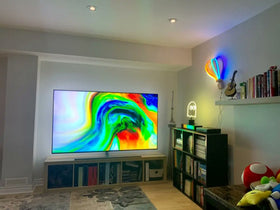Proper bias lighting plays a critical role in creating an ideal viewing environment for accurate color perception and visual comfort. The goal is to introduce controlled ambient light into the space surrounding your display, reducing eye strain and improving image clarity without affecting the on-screen colors. MediaLight bias lighting products are specifically engineered to meet the highest industry standards for color accuracy and performance.
Why Use Bias Lighting?
When watching TV or working in dimly lit environments, your pupils dilate to adjust for the darkness. This can cause difficulty in perceiving subtle details in bright areas of the screen while simultaneously over-exposing your eyes to the display’s brightness. Bias lighting counteracts this by introducing low-level ambient light, which:
1. Reduces eye strain: By moderating rapid changes in brightness between screen content and the surrounding area.
2. Improves perceived contrast: Proper ambient light allows the eyes to adjust naturally, making blacks appear deeper and colors more vibrant.
3. Enhances color accuracy: A neutral light source surrounding the display minimizes color distortions caused by environmental lighting.
Extensive human factors research supports the benefits of bias lighting for prolonged viewing comfort and optimal image fidelity.
Key Requirements for Bias Lighting
1. Light Placement:
The light should be positioned behind the display, aimed away from the viewer to avoid glare. This placement creates a halo of diffuse illumination, which enhances the viewing experience without reflecting off the screen.
2. Color Temperature:
A bias light must have a correlated color temperature (CCT) of 6500K (D65 standard). This neutral white light aligns with industry standards for color-critical work, such as video editing, and ensures the display’s color accuracy isn’t compromised.
3. High Color Rendering Index (CRI):
For precise color reproduction, the bias light should have a CRI of 90 or higher. MediaLight bias lighting achieves a CRI of 98, with an exceptional spectral similarity to D65, ensuring that colors appear as intended, without skewing hues or saturations.
4. Brightness Level:
The SMPTE Recommended Practice specifies that the light’s intensity should not exceed 10% of the display’s peak brightness. MediaLight products include dimming controls, allowing you to adjust the brightness to an optimal level, typically around 5% for most environments.
What About the Wall Color?
The color and finish of the wall behind your display can influence the effectiveness of bias lighting and the accuracy of color perception. Here’s how to approach it:
• Neutral Colors are Best:
Ideally, the wall should be painted a neutral matte gray, such as Munsell N5 or N7. Neutral grays minimize color shifts and reflections that can distort the display’s appearance. However, less saturated colors, like light beige or pale blue, are far less disruptive than bold, vivid tones like cherry red or metallic gold.
• Matte Finishes are recommended:
A matte finish helps prevents glare or reflections. Glossy or shiny surfaces cause specular reflections and create visual distractions, which can degrade the viewing experience.
• Avoid Shiny or Reflective Surfaces:
Mirrors, windows, and other reflective surfaces behind or near the display are especially problematic. They can introduce unwanted glare, compromise perceived black levels, and disrupt focus. If reflective surfaces are unavoidable, consider adding curtains or repositioning the display to reduce their impact.
While a neutral, matte backdrop is ideal, it’s not a dealbreaker for casual viewing. The light you use has a far greater impact on your perception of colors than the paint on your walls.
Modern vs. Legacy Bias Lighting Solutions
Traditional solutions like fluorescent lights filtered with gels are no longer practical or effective compared to modern LED-based bias lighting. MediaLight bias lighting systems represent the gold standard in contemporary bias lighting:
• Precise 6500K Calibration: Guaranteed to match D65 white point, ensuring color accuracy.
• Plug-and-Play Installation: Easy to attach behind any display, providing instant results.
• Dimming Options: Included dimmers let you fine-tune the brightness to your environment and display specifications.
• Energy Efficiency: LED technology consumes minimal power and generates negligible heat compared to outdated fluorescent or incandescent bulbs.
Debunking Myths: Bias Lighting and Interior Design
A common objection from decorators is that gray walls or neutral environments are aesthetically unappealing. However, a well-designed viewing space can be both functional and attractive:
• Use textured or patterned gray elements to add interest while maintaining neutrality.
• Incorporate design elements like neutral-colored blinds, shades, or light-diffusing panels.
• Remember that light impacts the perception of wall colors more than paint affects the light. A properly calibrated bias light ensures accurate color perception regardless of wall paint.
Transitioning to Proper Bias Lighting
Switching to a professionally calibrated bias lighting setup may initially feel unfamiliar, especially if you’re used to warm, yellow lighting or colorful surroundings. However, viewers quickly adjust to the new environment, often reporting better color perception and reduced fatigue after just a few days of use.
Why MediaLight?
MediaLight stands apart due to its unparalleled accuracy and quality. Whether you’re a professional colorist or a casual viewer, MediaLight products ensure that your display performs at its peak by:
• Adhering to SMPTE, ISF and CIE standards.
• Delivering unmatched color fidelity with extremely high CRI.
• Providing a simple, all-in-one solution for creating the perfect viewing environment.
Conclusion:
Bias lighting is essential for an optimal viewing experience. A 6500K bias light from MediaLight can dramatically improve your visual experience even in a typical home setting. MediaLight offers the perfect combination of precision, performance, and ease of use, helping you enjoy reduced eye strain, improved contrast, and accurate color reproduction—all without sacrificing comfort or style.


